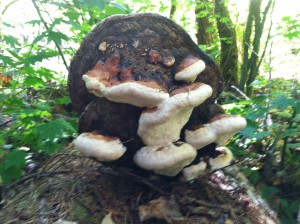Fomitopsis pinicola
This is the red-belted conk, a polypore common in our area. It is the cause of brown crumbly rot.
Description: Hoof-shaped woody fruiting bodies that have a white pore layer and a cap that is reddish toward the outer edges. The cap surface is smooth and the pore layer usually has 4-5 pores per mm.
Red-belted fungi growing on a Ganoderma specimen which is growing on a downed bigleaf maple. (Photo by Yianna Bekris).
Identification: The common name of this polypore originates from a distinctive “red belt” on the edge of the cap of mature specimens. Although brown rot, a rot characterized by the decay of cellulose and the brown color of the remaining lignin, is common enough and has many fungal causes. Presence of brown rot alone does not mean that the tree is infected with red belt fungi. However, if you find the pretty red belted conks you can be sure of it.
Hosts: Most conifers in western Washington.
Distribution: Common throughout the Northwest.
General Information: The red belt fungus plays an important role in Northwest forest ecology. It is often one of the first species of fungus that colonizes dead or dying trees.
References:
http://www.mushroomexpert.com/fomitopsis_pinicola.html
Field Guide to the Common Diseases and Insect Pests of Oregon and Washington Conifers

Leave a Reply